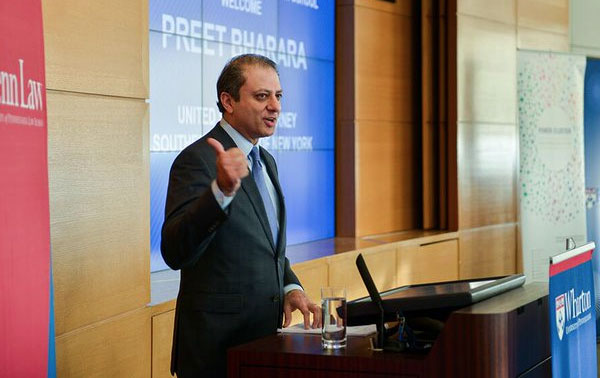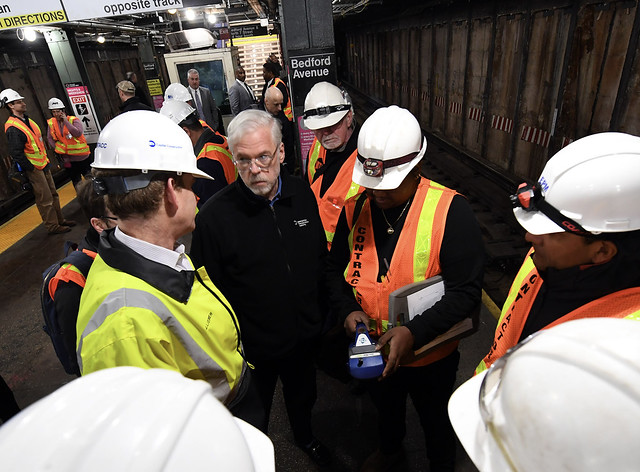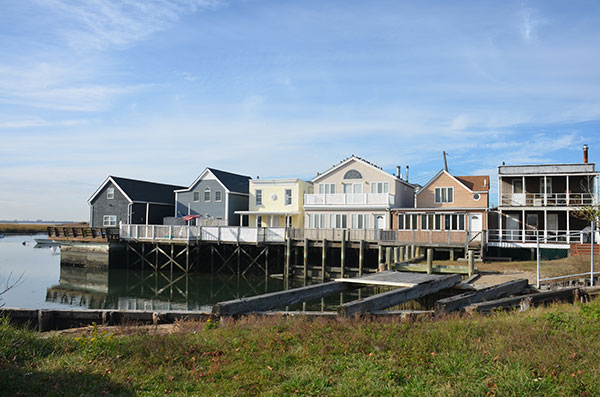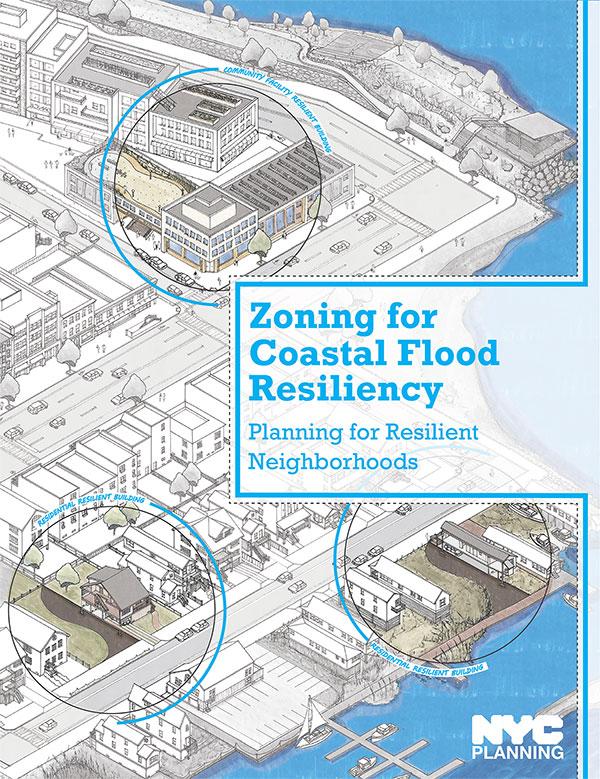Mass Gang Takedowns are Not ‘Doing Justice’

Preet Bharara (photo: @PennLaw)
Former U.S. Attorney Preet Bharara has a new book entitled Doing Justice, which is designed to further establish his position within the “Trump Resistance” by playing up his commitment to the rule of law in the face of the politicized actions of the Trump Justice Department. In it he argues that there is no place for politics in the decisions about which cases to take on and how to prosecute them.
"Certain norms do matter,” Bharara writes. “Our adversaries are not our enemies; the law is not a political weapon; objective truths do exist; fair process is essential in civilized society.”
But this rhetoric of justice and legal formalism stands in sharp contrast to his role in prosecuting young people from the Bronx accused of being “the worst of the worst” as part of the Bronx 120 “gang takedown.”
In 2016 the NYPD and a variety of federal agencies conducted the largest mass arrest of alleged gang members in New York City history, rounding up 120 individuals. Then U.S. Attorney for the Southern District of New York, Bharara undertook the prosecution of those cases using the broad powers of the Racketeering Influenced Corrupt Organizations (RICO) Act. He alleged that these were hardened criminals who had created a vast criminal enterprise that was terrorizing their Bronx community.
Those arrested faced severe felony charges that caused almost all of them to accept plea deals after being held without the possibility of bail for up to two years.
A recent study of the outcomes of these 120 cases by CUNY Law Professor K. Babe Howell calls into question whether the interests of justice were served in these cases.
Howell’s report documents that after three years of court proceedings, 80 of the 120 were not convicted of a violent crime, a third of the defendants spent between zero and two years in prison, and 35 of those arrested were only convicted based on conspiracy to sell marijuana. She also found that almost all the defendants were eligible for a public defender, suggesting that these defendants had no financial resources despite supposedly belonging to a major “criminal enterprise.”
In fact, only around half of the defendants were ever even accused of being gang members. Nearly half of those arrested, including those facing the most serious charges, had already been convicted in state court for the same conduct; some were in prison or jail at the time of arrest.
On the other hand, in one case, Kraig Lewis was arrested in another state while completing a master’s program. He was beating all the odds. He had studied hard through college, as a scholar-athlete, playing basketball, running track, and making the dean’s list. In 2013, he graduated with a bachelor’s degree in criminal justice. He decided to enroll in an MBA program, and was excelling at it, all while paying it back to his community. He coached a kids’ basketball team and created and organized a “Stop the Violence” basketball tournament aimed at raising awareness of gun violence in inner city communities. And through it all, he was raising a young son.
In his final semester of grad school in 2016, on track to receive his MBA, Kraig was arrested in the Bronx 120 raid. The U.S. Attorney’s Office, headed by Bharara, argued that he should be detained without bail, even though he had no criminal record, and had never been in trouble. His classmates graduated, and walked the stage to receive their diplomas. Kraig sat in jail. His six-year-old son went to school without his dad to walk him there. He celebrated birthdays and milestones. He didn’t understand why his dad was gone.
Kraig is out now. He was given a sentence of time served for conspiracy to distribute narcotics (marijuana). But his life is not the same. He remembers seeing a friend stabbed in the neck while he was in jail. He remembers missing his son’s birthdays. He remembers how full of potential his life was, before the arrest. Even though he completed his MBA program through another school while in jail, his future is not the same. Not with a felony conviction.
These prosecutions were clearly political in nature. Bharara and then-NYPD Commissioner Bill Bratton went to extensive lengths to demonize the people arrested in the Bronx 120 raid and presented the public a false narrative that this and other such raids are the way to make communities safer.
Arresting large numbers of people because of their alleged involvement with marijuana dealing, re-arresting people already in prison to produce a show trial, and branding young people struggling to make a future for themselves with a felony record is not justice and it doesn’t create long-term safety for their communities.
Bharara was confronted with the accusations Wednesday night at a Brennan Center event at NYU Law School by the moderator, Margaret Hoover of Firing Line on PBS. He responded that he acted on the advice of the NYPD, whose officials argued that this was the way to respond to an acute crisis of violent crime. He also pointed out that there was community support for some of the other raids he prosecuted in Westchester County.
This defense doesn’t really get to the heart of the issue, and doesn’t match Bharara’s other rhetoric. Prosecutors are supposed to make independent assessments of what is going to produce real justice, not just take the word of the police or respond to the loudest voices in a community. And they certainly shouldn’t agree to broad-based sweeps as conspiracy indictments.
Bharara himself admitted that criminal justice-led solutions, whether directed at violence or Wall Street corruption are unlikely to be successful on their own. We need a more holistic approach that understands the limits of deterrence-based strategies.
This is exactly correct. Instead of relying on police to give us ever-larger groups of socially-networked defendants and putting them in prison for ever-longer sentences, we need to legalize marijuana, provide community-based violence reduction efforts such as Cure Violence, and invest in the lives of young people so that they have real pathways to economic self-sufficiency.
Preet Bharara claims to be “doing justice,” so it is time for him to admit that these mass raids and RICO conspiracy cases are unjust and that those arrested should be given clemency.
***
Alex S. Vitale is professor of sociology and coordinator of the Policing and Social Justice Project at Brooklyn College and the author of The End of Policing. On Twitter @avitale.
***
Have an op-ed idea or submission for Gotham Gazette? Email This email address is being protected from spambots. You need JavaScript enabled to view it.
18 Steps to Increase Transparency at the MTA and Help Restore Public Trust

MTA Chair Pat Foye (photo: Marc A. Hermann/MTA)
In recent weeks, Pat Foye, the new CEO/Chair of the Metropolitan Transportation Authority (MTA) has twice publicly committed to improving the Freedom of Information Law (FOIL) and open data processes at the MTA. This is welcome news and an essential step forward for a government authority that has lost a great deal of public trust and is widely perceived as being politicized by the governor’s office. Our organization, Reinvent Albany, will strongly support this push by Foye and we hope it is a small down payment on a new culture of openness.
The MTA is widely seen as having a serious credibility problem with the public and state Legislature. This loss of trust has been aggravated by the tendency of the authority’s top management to treat routine matters as emergencies that must be addressed suddenly, in secret, and outside of existing rules and normal processes. Some days, the MTA seems to operate more like the CIA than a public transit agency. This hurts public confidence in the agency and reduces the political support it needs to make tough decisions about spending and service disruptions.
For its own good, the MTA needs to act like a public transit agency, not the CIA. The core of New York’s Freedom of Information Law is that “a free society is maintained when government is responsive and responsible to the public.”
In the fight for congestion pricing, which Reinvent Albany strongly supports, members of the New York State Legislature expressed frustration at the MTA’s secrecy, and constantly questioned the credibility of information provided by the authority. Some of this was political theatrics by opponents of congestion pricing. But even allies of the MTA were critical, highlighting the gap between the public’s expectations that the MTA be open and honest, and the agency’s habit of shading statistics, telling partial truths, and making it difficult for the public to see underlying data -- including on high-profile issues like Con Edison-caused service disruptions and fare evasion.
We believe the MTA’s lack of candor and transparency is hugely self-defeating and has led directly to the Legislature imposing more and more reporting requirements, including a host of new ones in this year’s state budget.
Fortunately for the MTA, there is a clear path forward on transparency. In early April, Reinvent Albany released Steps Forward for MTA FOIL and Open Data, a comprehensive report on transparency at the MTA, with 18 specific recommendations about how it can improve transparency. We urge the MTA to examine these recommendations, summarized below, and move toward “open by default.” Here are18 Steps Forward for MTA FOIL, Open Data and Transparency:
Open FOIL
1. The MTA should adopt an Open FOIL platform using best practices from other jurisdictions such as LA Metro, the Port Authority of NY/NJ, and within New York State such as NYC Open Records. FOIL requests should be used to prioritize proactive release of information via a “Reading Room.”
2.The MTA should create an in-house MTA Police incident reports portal, allowing the public to privately request incident reports online (incident reports currently make up two-thirds of all MTA FOIL requests). The MTA should work with the NYS DMV to develop their own portal, like the state’s crash reports portal. Other user-friendly models include the State of Pennsylvania crash reports site.
Open Data
The MTA should publish all tables, charts and other tabular data from their performance reports, capital plans, budget documents, Board materials, and other reports as open data. This should include:
3. Full compliance with Executive Order 95, requiring the publishing of all public MTA data on the New York State Open Data portal. Legislation should be considered in this area if compliance cannot be achieved administratively.
4. Release of all underlying datasets that are used to create MTA performance metrics, with full release of methodologies and API access (allowing apps to interface the data automatically).
5. Creating a contracts database that provides full and complete information about projects and vendors.
6. Providing all data from current MTA Board and Budget materials well in advance of meetings in machine-readable, CSV spreadsheet form.
7. Creating an MTA “Open Budget” website for the MTA’s budget information, similar to the state Open Budget NY site.
Budget and Capital Plan Transparency
8. Capital Planning Oversight Committee Materials should be improved through releasing all data in machine-readable, CSV spreadsheet form. Data should always include original project schedules and budgets. All current projects should be listed in the “Traffic Light” report, including those in the CPOC’s Risk-Based Monitoring Program.
9. Budget Documents should be made open and more complete, and released in machine-readable, CSV spreadsheet form. Budget Documents should also provide detailed breakdowns of past yearly expenditures and revenues, going back at least 10 years for both the capital and expense budget, comparing them with past projections.
10. MTA Capital Dashboard should be updated and improved, with improved timeliness of data updates, ensuring that all click-through data can be downloaded in bulk, more data such as contract numbers. The MTA should hold a user-group feedback session to identify additional improvement areas, and expand the “FAQs” Section.
Better Understanding Itself and Its Riders
11. The MTA should conduct and publicly release in an open data format an updated demographic analysis of its riders that looks at age, median individual and family income, race, ethnicity, gender, profession, disability, geographic locations, travel times, and other metrics.
12. The MTA should release more detailed methodology and tabular data about its fare evasion statistics, such as data broken out by borough, subway line, etc.
13. The MTA should release publicly, in an open data format, all data from its customer service portal and all staff analyses of the portal, polls and surveys.
14. The MTA should publicly release, in an open data format, its submission to the FTA of its Transit Asset Management (TAM) plan and the update to its 20-Year Needs Assessment.
15. MTA staff should conduct and release an in-depth “lessons learned” report about installation of Communications Based Train Control (CBTC) on the 7 Line.
Open Meetings Law
16. The Capital Program Review Board (CPRB) should comply with the Open Meetings Law to ensure that all of its deliberations are conducted in public meetings, in particular its votes to approve capital plans and their amendments.
17. A website should be created for the CPRB where it publishes its mission, activities, members, calendar of meetings, meeting minutes and materials, and contact information.
18. All future commissions, advisory workgroups, and other public bodies formed by law to provide recommendations regarding the MTA should fully abide by the Open Meetings Law.
***
Rachael Fauss is Senior Research Analyst and John Kaehny is Executive Director at Reinvent Albany. On Twitter @ReinventAlbany.
***
Have an op-ed idea or submission for Gotham Gazette? Email This email address is being protected from spambots. You need JavaScript enabled to view it.
Zoning for a More Resilient Future

(photo: City Planning Department)
As the threat of climate change grows more prevalent by the day, cities must take the lead in reducing our carbon footprint and becoming more resilient. This year, New York City has taken a big, green step forward, with actions by Mayor Bill de Blasio and the City Council that will decrease our emissions.
When it comes to withstanding the storms and flooding that climate change will bring more frequently, though, it’s vital that existing zoning rules don’t stand in the way of protective measures for the buildings that make up our coastal communities. As sea levels rise, so too will flood waters and we must make certain that zoning accounts for future risk.
Shortly after Hurricane Sandy devastated our coastal communities, the City adopted emergency zoning to enable homeowners to rebuild to more resilient standards, based on the then-newly provided flood maps produced by the Federal Emergency Management Agency (FEMA).
These zoning changes allowed property owners to raise living space and mechanical equipment to a higher elevation that could otherwise wind up under water. They also expire one year after FEMA creates new flood maps. But there’s no telling when the next storm may hit.
When it comes to building or renovating, the hundreds of thousands of residents and businesses in the floodplain can’t be kept in limbo. We need to provide guidelines for how buildings can be constructed or retrofitted to better withstand or recover from storms and flooding. This affects roughly 400,000 residents in today’s flood zone, an area that could increase in size to cover nearly 800,000 New York City residents by the 2050s due to sea level rise.
 With years of lessons from Sandy recovery and community outreach, we’ve created Zoning for Coastal Flood Resiliency, rules tailored to New York’s diverse neighborhoods, building types, uses and needs, as well as increased storm and flood risk from climate change.
With years of lessons from Sandy recovery and community outreach, we’ve created Zoning for Coastal Flood Resiliency, rules tailored to New York’s diverse neighborhoods, building types, uses and needs, as well as increased storm and flood risk from climate change.
We have listened to communities throughout the City’s flood zones to understand the challenges they face both from storms and increased chances of flooding due to climate change. Zoning for Coastal Flood Resiliency is responsive to what we heard and will allow New Yorkers to make smart choices when retrofitting or rebuilding.
The proposal’s main goals include:
Expanded geography: We saw during Hurricane Sandy that floodwaters ignore lines drawn on maps. Much flooding occurred well beyond the boundaries of the old Flood Maps. With climate change and rising sea levels, storms will become more frequent and floodwaters will travel further inland. We’re expanding the proposed zoning protections from the 100-year floodplain to the 500-year floodplain, ensuring that an additional 44,600 buildings in the city that house nearly 350,000 additional residents can become more resilient.
Flexibility for resiliency: Residents told us that current zoning often forces their resilient measures to eat into living space in their homes. In response, we propose to allow sea level rise to be factored into designing new buildings or retrofitting existing ones, offering more room for resiliency. This flexibility will give resilient buildings a decreased chance of property damage from a future storm and likely reduced flood insurance costs.
Alternatives for the relocation of important equipment: For buildings to quickly get back up and running after flooding, it’s critical that their mechanical, electrical and plumbing equipment or back-up systems are above floodwaters. The zoning would allow them to be elevated.
On a personal and a macro level, New Yorkers are still feeling the impact of Hurricane Sandy. It’s imperative to apply lessons learned from that disaster and emerge stronger. These zoning measures will help individual property owners prepare for a resilient future.
This is just one piece of the puzzle. When combined with the City’s investments in coastal protection and the hardening of our infrastructure, we can provide real and tangible risk reduction from coastal storms.
***
Michael Marrella is Director of Waterfront and Open Space at the Department of City Planning. On Twitter @NYCPlanning.
***
Have an op-ed idea or submission for Gotham Gazette? Email This email address is being protected from spambots. You need JavaScript enabled to view it.




